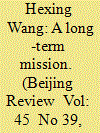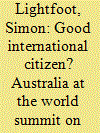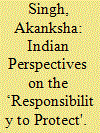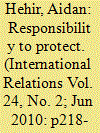|
|
|
Sort Order |
|
|
|
Items / Page
|
|
|
|
|
|
|
| Srl | Item |
| 1 |
ID:
022531


|
|
|
|
|
| Publication |
Sept 26, 2002.
|
| Description |
8-11
|
|
|
|
|
|
|
|
|
|
|
|
|
|
|
|
| 2 |
ID:
073367


|
|
|
|
|
| Publication |
2006.
|
| Summary/Abstract |
Australia has often been identified as a middle power in foreign policy terms. This article assesses the worth of the concept in understanding the role of Australia in global environmental governance. Using a case study of the role played at the World Summit on Sustainable Development, it assesses whether Australia conformed to a classic middle power role, building coalitions as a 'good international citizen' or whether its role was more like a veto state, preventing positive change. This is done via a reflection of Australia's Summit priorities and an assessment of its impact over the Summit outcomes. The article shows that Australia was able to offer leadership in certain specific areas, but overall domestic policy preferences, a growing mistrust of multilateralism, and a strong defence of the national interest meant that Australia played the role of a veto state, often in coalition with the United States of America.
|
|
|
|
|
|
|
|
|
|
|
|
|
|
|
|
| 3 |
ID:
173228


|
|
|
|
|
| Summary/Abstract |
The concept of ‘Responsibility to Protect’ (R2P) took shape to refine the contested concept of ‘humanitarian intervention’. In the initial phase, the concept of R2P did not receive enthusiastic endorsement. Developing countries including India perceived it as a new body with the old spirit and likened it with the concept of humanitarian intervention, and this was reinforced by the US-led war against Iraq in 2003. However, the 2005 World Summit proved to be a watershed in the evolution of R2P, just as it is a landmark to understand an important phase of India’s approach to the idea. It would not be accurate to characterize India as a determined nay-sayer on R2P endorsement, particularly in view of the widely known priority India attached at the World Summit to the question of United Nations (UN) Security Council enlargement. Eventually, by 2009 (with the introduction of ‘three- pillar principles’ of R2P), India became a major proponent for the cautious and legitimate implementation of R2P. However, the experiences gained from Libya made India become a voice of caution in invoking forcible options under the R2P principle in Syria. In this article, the attempt has been made to articulate various permutations and combinations regarding India’s evolving approach to R2P on a case-by-case basis
|
|
|
|
|
|
|
|
|
|
|
|
|
|
|
|
| 4 |
ID:
147701


|
|
|
|
|
| Summary/Abstract |
This article situates the emergence of the Responsibility to Protect (R2P) concept, later accepted by many as a principle, in the wider flow of events following on the end of the Cold War. Among the hallmarks of change in the United Nations (UN) Security Council as of the early 1990s, in stark contrast to the Council’s preoccupations during its first four decades of activity, was its growing attention to humanitarian considerations relating to conflict, its new willingness to tackle conflicts (mainly internal ones) it might have avoided earlier, and its willingness to experiment with new approaches to resolving them. Just as worries over terrorism and the threat of weapons of mass destruction were to become dominant themes in its work, the humanitarian imperative also incrementally wove itself into the fabric of the Council’s decision-making. It is against this wider backdrop and that of several spectacular UN failures to prevent genocide and other mass humanitarian distress that UN Secretary-General (UNSG) Kofi Annan was impelled as of 1999 to look beyond existing international law and practice for a new normative framework, that while formally respecting the sovereignty of states nevertheless elevated humanitarian concerns and action to the level of an international responsibility to prevent the worst outcomes. Today R2P finds itself competing with other legal and diplomatic principles, but it remains a potent platform for advocacy and, at times, for action by the UN.
|
|
|
|
|
|
|
|
|
|
|
|
|
|
|
|
| 5 |
ID:
097808


|
|
|
|
|
| Publication |
2010.
|
| Summary/Abstract |
The term 'Responsibility to Protect' (R2P) has dominated debate on humanitarian intervention since the publication in 2001 of the report of the International Commission on Intervention and State Sovereignty (ICISS). Today 'R2P' has become a seemingly obligatory reference point for all researchers in this field and R2P's near ubiquity is testament to the effective marketing of the idea. This article will argue, however, that the currency of the term obscures its hollowness. R2P has undeniably changed the discourse surrounding humanitarian intervention, and possibly broadened interest in the subject, but it has contributed little of substance or prescriptive merit. Though the report was drafted with the mandate to reconcile international human rights with state sovereignty it fudged the key issues, namely, substantive reform of the United Nations Security Council, the legitimacy of unilateral humanitarian intervention and the threshold for intervention. The shift in focus from response to prevention since 2001 evades the key issue which prompted the ICISS to draft its report and fails to provide a viable or innovative approach.
|
|
|
|
|
|
|
|
|
|
|
|
|
|
|
|
|
|
|
|
|